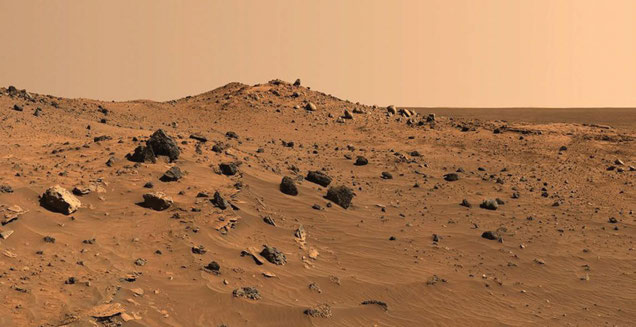
WASHINGTON (TIP): Martian pebbles travelled roughly 50 kilometres down a riverbed from their source, according to a new study that provides evidence Mars once had an extensive river system, conditions that could support life.
While recent evidence suggests that Mars may harbour a tiny amount of liquid water, it exists today as a largely cold and arid planet.
Three billion years ago, however, the situation may have been much different, researchers said.
In 2012 the Mars Curiosity rover beamed images back to Earth containing some of the most concrete evidence that water once flowed in abundance on the planet.
Small, remarkably round and smooth pebbles suggested that an ancient riverbed had once carried these rocks and abraded them as they travelled.
Douglas Jerolmack, from the University of Pennsylvania, and Gabor Domokos, of Budapest University of Technology and Economics, and colleagues report the first-ever method to quantitatively estimate the transport distance of river pebbles from their shape alone.
The researchers’ estimate that the Martian pebbles travelled roughly 50 kilometres from their source, providing additional evidence for the idea that Mars once had an extensive river system, conditions that could support life.
Determining how far pebbles have travelled could also be useful for studies on Earth, for example in identifying sources of river-transported resources, such as gold.
“An object’s shape can itself tell you a lot. If you go to the beach, natural history is written underneath your feet. We started to understand that there is a code that you can read to begin to understand that history,” said Domokos.
Rocks flowing in rivers evolve in shape from being abraded against other rocks in the riverbed, gradually losing mass and taking on a smoother, rounder shape.
Domokos’ work showed that, when two particles of similar size bang together, the way in which they influence each other’s shape can be reduced to a purely geometric problem, regardless of the rock’s material or the environment in which it is moving.
The research team went to the lab to test this theory, rolling limestone fragments in a drum and periodically pausing to record their shape changes and mass loss.
The pattern of the rocks’ shape change closely followed the curve established by the mathematical theory.
Next the researchers went to a mountain river in Puerto Rico.
Plotting the data, they again found a trend between shape evolution and mass loss that agreed with the geometric model Domokos had developed.
Applying their calculations to the basalt material found on Mars, with a correction that factored in the reduced Martian gravity, they arrived at the calculation that the pebbles had travelled an estimated 50 kilometres, or about 30 miles from their source.





Be the first to comment